It is relatively easy to setup the drive for operation. Since the motor drive needs battery to power its function, first you have to load the battery into the battery compartment. The MD-12 is powered by eight 1.5V penlight (AA size) batteries which are housed in the unit's battery chamber. To load or replace batteries, turn the coin slotted locking screw on the battery chamber lid counterclockwise. The lid will come loose and the battery clip, which forms a single unit with the lid, can be removed. Load the batteries, taking care that they are inserted correctly. Referring to the diagrams on the sides of the clip that show the correct ~way to insert the batteries, ensure that the polarity of the indication on the cells: positive (+) and negative ( - ) terminals of the batteries are properly positioned. If the batteries are loaded incorrectly, not only will they be depleted - the motor drive could also be damaged. When the batteries are correctly positioned, replace the battery clip. Push the chamber lid down gently until it seats correctly; then, tighten the locking screw on the lid with a coin or similar object until the battery clip fits securely into the battery chamber.
Note: Battery performance varies greatly,
depending on its type and age, as well as on operating conditions, including temperature.
Consequently, the number of rolls that can be exposed with one set of batteries cannot
be accurately predicted. As a guide, however, you can expect to be able to expose
more than a hundred 36-exposure rolls of film per set of alkaline-manganese batteries.
Since batteries have poor low-temperature characteristics, battery performance diminishes
considerably as the temperature decreases. This results in slower shooting speed
and reduced film transport capacity. From the manual, Nikon stated that Alkaline
manganese batteries, in particular, suffer severely at temperatures below 0 C. (As
my country is warmth and sunny all year round, not appropriate for me to comment,
you may do so in the message board). However, the MD-12 can use lithium batteries
to extend its operational limit on such application or for normal use - but generally,
normal Alkaline cells is good enough and it is much economical.
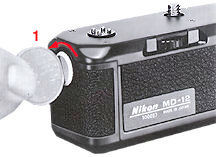 |
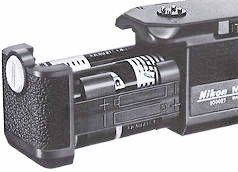 |
With the battery properly install, you need to mount the drive on your camera. The MD-12 has been designed such that it can be attached or removed at any time regardless of whether or not the camera is loaded with film. Before attaching the MD-12, make sure that its power switch is turned off. Then, position the motor drive on the camera's bottom plate, its hand grip should be at the same end of the camera as the film advance lever. Ensure that the raised ring around the drive shaft is correctly seated inside the locating collar, coaxial with the camera's film advance coupling. Then, fasten the motor drive's attachment screw, turning it clockwise by means of the thumb wheels on either side. Simultaneous use of both forefinger and thumb will speed up attachment. Make sure there is no gap between the motor drive and the camera body; then tighten the attachment screw firmly.
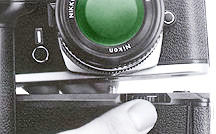 |
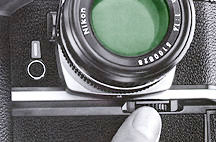 |
Important: Make sure when you perform this task of mounting the drive to your camera body, the power switch on the back of your camera is turn off to avoid possible electrical surge on wrong contact with the electrical terminals. The drive will advance upon wrong contact and since it might move 'violently' when it has nothing to hold onto, such action may damage the pins and cause unnecessary replacement/repairing cost. Although the MD-12 has a ground to protect, but it is still advisable to note this.
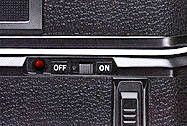 |
I know it is very hard to press people to pay attention to these minor things, because it is not a very frequent process to change or re-mount a motor drive unit. It needs to experience once to remember for the rest of your life. I am more concern if such thing happens, you may get a shock and drop your camera ... just don't complaint that I have never reminded you of these. |
| Back | to Index Page of
MD-12 | * MD-11
|
Back | to Main Index Page
Shared Resources
Instruction
Manual
: PDF (224k)
3rd
Party Power Winder Only for FM2(n)/FE2/FA
Specification: PDF(121k) | HTML
Operation manual (PDF Format:
202k)
| Back | to Main Index Page Shared
Resources (Screens, Databacks and general accessories)
| Message Board | for
your favourite Nikon
FE series models
| Message Board | for
your favourite Nikon
FM series models
| Message Board | for
your favourite Nikon
FA series models
| Message Board | for your Nikon Optics
in a shared environment
| Message Board | Specifically for Dispose or Looking for Nikon / Nikkor
Photographic Equipment
Shared Resources: MD-11 | MD-12 | 3rd Party Power Winder Only for FM2(n)/FE2/FA | Focusing Screens | Titanium Shutter | Flash Units - | SB-15 | SB-10 | SB-16B & Other Options | Databack | Nikkor lens mount (related info)
Others:- Nikon AF-TTL Speedlights | SB-20 (1986) | SB-22 (1987) | SB-23 | SB-24 (1988) | SB-25 (1991/2) | SB-26 (1994) | SB-27(1997) | SB-28 (1997) | Nikon SB-29(s) (2000) | Nikon SB-30 (2003) | Nikon SB-600 (2004) | Nikon SB-800 (2003) Nikon AF-TTL Speedlight DX-Series: Nikon SB-28DX (1999) | SB-50DX (2001) | SB-80DX (2002)
Nikon
BC-flash Series |
Original
Nikon Speedlight
SB-2
| SB-3
| SB-4
| SB-5
| SB-6
| SB-7E
| SB-8E
| SB-9
| SB-E
| SB-10
SB-11
| SB-12 | SB-14 | SB-140 UV-IR| SB-15 | SB16A | SB-17 | SB-18, SB-19 | SB-21A (SB-29) Macro flash | Flash Accesories | SF-1
Pilot Lamp
| Nikon F | Nikon F2 | Nikon F3 | Nikon F4 | Nikon F5 | Nikon F6 | Nikkormat / Nikomat | Nikon FM | Nikon FE/ FA | Nikon EM/FG/FG20 | Nikon Digital SLRs | Nikon - Other models |
Nikon Auto Focus Nikkor lenses:- Main
Index Page
Nikon Manual Focus Nikkor lenses:- Fisheye-Nikkor Lenses - Circular | Full Frame |
Ultrawides Lenses - 13mm15mm18mm20mm | Wideangle Lenses - 24mm28mm35mm | Standard Lenses - 45mm 50mm 58mm | Telephoto
Lenses - 85mm105mm135mm180mm & 200mm | Super-Telephoto Lenses - 300mm 400mm 500mm 600mm 800mm 1200mm |
 Index Page |
Special
Application lenses: Micro-Nikkor Lenses - 50mm~55mm -60mm 85mm -105mm 200mm Micro-Zoom 70-180mm Perspective Control (PC) - 28mm 35mm PC-Micro 85mm Dedicated Lenses for Nikon F3AF: AF 80mm f/2.8 | AF 200mm f/3.5 EDIF Depth of Field Control (DC): 105mm 135mm Medical Nikkor: 120mm 200mm Reflex-Nikkor Lenses - 500mm 1000mm 2000mm Others: Noct Nikkor | OP-Nikkor | UV Nikkor 55mm 105mm | Focusing Units | Bellows-Nikkor 105mm 135mm Nikon Series E Lenses: 28mm35mm50mm100mm135mm | E-Series Zoom lenses: 36~72mm75~150mm70~210mm |
MF Zoom-Nikkor Lenses: 25~50mm | 28~45mm | 28~50mm | 28~85mm | 35~70mm | 36~72mm E | 35~85mm | 35~105mm | 35~135mm | 35~200mm | 43~86mm | 50~135mm | 50~300mm | 70~210mm E | 75~150mm E | 80~200mm | 85~250mm | 100~300mm | 180~600mm | 200~400mm | 200~600mm | 360~1200mm | 1200~1700mm
Tele-Converters: TC-1 | TC-2 | TC-200 | TC-201 | TC-300 | TC-301 | TC-14 | TC-14A | TC-14B | TC-14C | TC-14E | TC-16 | TC-16A | TC-20E
Recommended links to understand more technical details
related to the Nikkor F-mount and production Serial Number:
http://rick_oleson.tripod.com/index-153.html by: my
friend, Rick Oleson
http://www.zi.ku.dk/personal/lhhansen/photo/fmount.htm by: Hansen,
Lars Holst
http://www.mir.com.my/rb/photography/hardwares/nikonfmount/lens2.htm
http://www.photosynthesis.co.nz/nikon/serialno.html
W A R N I N G: The New G-SERIES Nikkor lenses have no aperture ring on the lens, they CANNOT ADJUST APERTURES with any of these manual focus Nikon FE series SLR camera models; please ignore some portion of the content contained herein this site where it relates.
|
Back | Main Index Page of Nikkor Resources
|
Back | Main Index Page of Pictorial
History of Nikon SLRs
| Message Board | for your Nikkor optics ("shared" because I do wish some of you to expose to other's perspective as well. Isn't it a sad sate to see photography has to be segmented into different camps from the use of various labels)
about this photographic web site
Home - Photography in Malaysia |
A contributing effort to Michael C Liu's Classic Nikon Site.
Credit: Chuck Hester for some of his beautiful images used in this site; Ted Wengelaar®, Holland for his continuous flow of input; Lars Holst Hansen, Danish 'Hawkeye' who shares the same passion; Mr Poon from Poon photo for their input; Ms Miss Rissa (Sales Manager) & members of the Technical Service dept. of Shriro Malaysia, local distributor of Nikon cameras in Malaysia & Singapore, in providing so many useful input to make this site possible. Special thanks to Mr MC Lau, who has helped with his images of the MF-12 databack. Michael Tan, Pertama Photo (603-2926505) for lending his original Titanium Shutter Display Unit. Dave Hoyt who has prepared the introductory page and offer some images of his FE2 in this site.. Hiura Shinsaku, Nikomat ML, Japan for his contribution on all the various images; A contributing site to a long lost friend on the Net. Note: Certain content and images appeared in this site were either scanned from official marketing leaflets, brochures published by Nikon and/or contribution from surfers who claimed originality of their own work to publish in this site based on educational merits. The creator of this site will not be responsible for any discrepancies that may arise from such possible dispute except rectifying them after verification."Nikon", "Nikkormat", "Nippon Kokagu KK" & "Nikkor" are registered tradename of Nikon Corporation Inc., Japan. Made witha PowerMac.